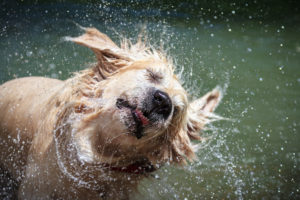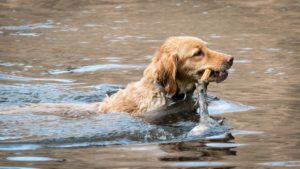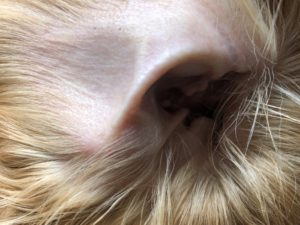If you have ever had a dog, you are probably familiar with dogs and ear infections. Ear infections are common for most dogs. Luckily the signs are pretty clear when our dog gets an ear infection, so we can help them out quickly.
most dogs. Luckily the signs are pretty clear when our dog gets an ear infection, so we can help them out quickly.
I am going to take a look at signs of ear infections, types of ear infections, prevention of ear infections, treatment and recommended ways to clean your dog’s ears.
Table of Contents
Signs Of Dog Ear Infections
There are several signs that your dog will show letting you know they have an ear infection. The good news is that it isn’t hard to figure out when they do. The bad news is that they can frequently get ear infections, and you need to figure out why it keeps happening.
Here are the signs of your dog having an ear infection.
- Scratching of the ear, more than normal.
- Rubbing the side of their face on any furniture they can find or against you.
- Shaking their head or the quick ear flip.
- Tilting their head or carrying their infected ear differently. You might notice that they let the infected ear droop more than the other ear.
- An odor coming from their ear.
- Redness or swelling in the ear.
- Brown or reddish discharge in the ear.
- Crusts or scabs inside the ear.
Types Of Ear Infections
For adult dogs, ear infections are usually caused by either a bacteria infection or a yeast infection. Ear mites are also possible, but this is more common with puppies.
Both yeast and bacteria grow in warm, dark and moist environments.
Bacterial Infections
This is the most common cause of ear infections in adult dogs. There is good bacteria in the dog’s ear, and the infection happens when the ear’s balance is upset with bad bacteria taking over.
The bad bacteria is generally from your dog swimming in contaminated lakes or ponds. The bacteria can enter the ear canal and crowd out the good bacteria.
ear canal and crowd out the good bacteria.
Good bacteria in the ear can also overgrow if the dog has a stressed immune system. If your dog has recurring bacterial infections, it could be from their stressed immune system.
Bacteria infections can not be cured from home remedies. You will need a prescription of antibiotics from your veterinarian in order to cure this type of ear infection.
Yeast Infections
Yeast infections can grow out of control if your dog’s immune system isn’t working properly. Generally when your dog gets a yeast ear infection, it is coming from allergies or hormone imbalances. The allergies could be from food or environmental meaning grasses or pollen.
Common food allergies are beef, chicken, fish and soy. If your dog has allergies, they are predisposed to getting ear infections. The inflammation that allergies can cause in the skin, allows an overgrowth of bacterial and yeast organisms.
If your dog only has a very few yeast ear infections, you don’t need to be overly concerned. But, if your dog is continually having recurring infections, you need to find the reason behind what is causing the ear infections. Your veterinarian would be a good source for helping you determine what your dog could be allergic to and help with a path for eliminating the cause.
Yeast infections can also be affected by medications your dog might be taking, an illness they had, their diet or the daily activity that they are getting. Too much sugary treats or snacks can change the yeast levels in your dog.
A yeast infection could be from something as simple as your dog rolling around in the heat and sun, running around

Rolling around in the sun and heat, can cause sweat in your dog’s ear.
or swimming. These activities can help water and sweat to gather in the nooks and creases of the ear canal, giving yeast a place to grow.
Prevention Of Ear Infections
There has been some discussion if dogs with floppy ears get more ear infections than dogs with prone ears. Both of them have their own obstacles. Floppy eared dogs keep the moisture in and provide a dark place for yeast and bacteria to grow. Dogs with prone ears are more open for dirt to easily get in their ears.
I have had both types of dogs, and they both equally got ear infections.
The best thing you can do for your dog to help prevent ear infections is making sure to dry out your dog’s ears after swimming or a bath. This will keep the moisture down in their ear canal, making it harder for yeast and bacteria to grow.
Clean your dog’s ears regularly. This will help remove any dirt that is in the ear canal and help keep your dog’s ear healthy.
If you have a dog with long fur, trim the fur out of and away from your dog’s ear. This will help keep their ears dry and more clean. Either have a groomer do this, or talk to your veterinarian about the best way to do it yourself.

Your vet might recommend removing some of this fur from your dog’s ear.
Treatment Of Ear Infections
The first time that your dog gets an ear infection, make sure and schedule an appointment with your vet to have it checked out. This will help you understand what type of ear infection your dog has. Remember, a bacteria ear infection can only be cured with an antibiotic ointment, drops, or pills.
Your veterinarian will take a sample from your dog’s ear canal and examine it under a microscope to identify what microorganisms are present. They will then be able to prescribe what course of medical treatment will work best to cure your dog’s ear infection.
Most times your dog will be prescribed either an ointment or drops to put directly into your dog’s ear canal. It is advised that first you clean your dog’s ears. This will allow the ointment or drops to have better contact to the affected tissue.
Let the ears dry for about 10 minutes and then add the medication to your dog’s ear.
The ear infection should be cleared up within 1 -2 weeks. The veterinarian will usually want a follow up visit at that time to make sure the infection is completely gone.
Severe cases might require oral medications or surgery.
Most ear infections are in the outer ear only. Untreated ear infections can spread to the inner ear and can result in permanent deafness, loss of coordination and balance and eye problems.
Cleaning Of Dog’s Ears
A routine ear cleaning will help prevent ear infections. Dogs that are healthy, their ears will usually take care of themselves. Clean them occasionally when there are signs of dirt. Make sure to properly dry your dog’s ears after a bath and swimming.
But there are some things to beware of before cleaning your dog’s ears.
Make sure to clean ear with a gentle cleaner. Make sure that your cleaner doesn’t contain acids (acetic acid, boric acid, lactic acid) or SD Alcohol 40. A normally healthy ear would be fine with these ingredients that are in many over-the-counter cleaners, but for an ear canal that is inflamed, it will be very painful for your dog.
Never use rubbing alcohol. This will also be very painful since the inflamed ear canal is like a bad rash.
Put some of the cleaner directly into your dog’s ear canal. Then using a cotton ball, gently rub it around in the ear to remove any dirt and remove excessive cleaner. Never use a cotton swab in your dog’s ear. They can push wax and debris deeper into the ear canal. You also run the risk of rupturing the ear drum.
Dog Ear Cleaners
There are some homemade ear cleaners that you can make, but never use these cleaners if your dog does have an ear infection. They all contain products that would be painful for an infected ear. These products are fine to use though, if your dog has healthy ears.
A common homemade ear cleaner is made with apple cider vinegar. The acetic acid in vinegar can kill bacteria and yeast growth.
Dilute apple cider vinegar with equal parts water. Soak a cotton ball in the solution. Gently dab your dog’s ear flap and on outer surface of ear.
There are also 3 over-the-counter cleaners that I recommend that work great. All of these would be safe to use even if your dog has an ear infection.
Virbac Epi-Otic Advanced Ear Cleaner
Mild alcohol free cleaning and drying solution. Comes in easy to use squirt bottle. Gentle enough to use regularly.
Curaseb Ear Flush
Contains Ketoconazole, which is anti fungal and anti yeast. Water based with aloe infused ear flush. Gentle enough to use regularly.
Pet MD Ear Wipes
These are disposal wipes that are gentle and safe for regular use. Alcohol free, soothing and non-irritating wipes. Contains aloe and eucalyptus.
Summary
The best treatment for a dog and ear infections is to completely avoid them by regularly drying out your dog’s ears when they get wet and occasionally cleaning them when it is needed. Keeping your dog on a healthy diet also reduces the chances of your dog ever getting an ear infection.

Let your dog’s have fun swimming, but dry their ears after swimming
If your dog does get an ear infection, make sure and get it treated right away. It is painful for your dog and the situation can worsen if it isn’t cared for.
Be careful of the type of cleaners you use on a dog that has an ear infection, and you can worsen their pain if it contains and acids, or alcohol as their ingredients. There are plenty of over-the-counter cleaners that don’t contain these ingredients that will be gentle to use.
If you have any questions or comments, please leave them below. If you found the article helpful, please follow us on Twitter, FaceBook or Pinterest.
Some of the links within this post are affiliate links of which I might receive a small compensation from sales of certain items.

Hi there Marla, thanks for a really informative article. I have two large dogs that occasionally get yeast ear infections and I have been quite vigilant checking and cleaning regularly to the point that when get the ear wash out my Lab runs off to hide, bless his little heart.
Cassandra, I have had a dog running from me also when I get my supplies out for cleaning their ears. They are so smart on everything that is going on around them. As long as you keep your dog’s ears clean, it should really help prevent the number of ear infections that your dogs get. Thanks for reading my article.